My Decoy Collection
 Smiles. The satisfied curves and earthy colors feel warm and cute. The lines and an unexpected woodgrain draw the mind into another time, before gridlock and the internet, a time one imagines to be simpler.
Smiles. The satisfied curves and earthy colors feel warm and cute. The lines and an unexpected woodgrain draw the mind into another time, before gridlock and the internet, a time one imagines to be simpler.
One of the joys of finally landing in our California cabin is that I have unpacked my humble collections, after three years of not having a home of our own. My folk art decoy duck collection is now scattered around the surfaces of my living space. They’re helping to bring a feel of home. place, and normalcy three years after I lost the home I’d had for nearly two decades.
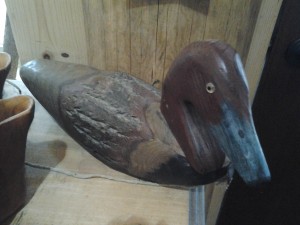 I supported myself during film school by doing eco-friendly housecleaning and organizing. On the organizing side, ninety percent of my consultation had to do with getting people to get rid of stuff, not just rearrange it. I liked the advice from several organizing books to put items in trash bags and put them in the attic, basement or closet for three months. Anything that you don’t go to the bags to get in that time is something you don’t need. Then the client or I would take the bags, unopened, to a local thrift store or charity. Of course, these trash bags were usually filled with eight of the client’s yellow sweaters, reams of old musty copier paper, surplus toys for the grandchildren that live across the country, etc. They didn’t tend to include the favorite artwork.
I supported myself during film school by doing eco-friendly housecleaning and organizing. On the organizing side, ninety percent of my consultation had to do with getting people to get rid of stuff, not just rearrange it. I liked the advice from several organizing books to put items in trash bags and put them in the attic, basement or closet for three months. Anything that you don’t go to the bags to get in that time is something you don’t need. Then the client or I would take the bags, unopened, to a local thrift store or charity. Of course, these trash bags were usually filled with eight of the client’s yellow sweaters, reams of old musty copier paper, surplus toys for the grandchildren that live across the country, etc. They didn’t tend to include the favorite artwork.
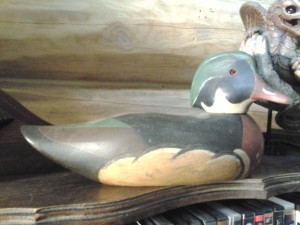 Even so, collections can seem counter to the lifestyle of simplicity. Collections can start to own the owner, like cars, large houses or possessions in general. So what is my relationship to my decoys now?
Even so, collections can seem counter to the lifestyle of simplicity. Collections can start to own the owner, like cars, large houses or possessions in general. So what is my relationship to my decoys now?
For three years my partner C.T. and I lived in an RV while our files, kitchenware, and assorted collections were in storage. I brought one carved decoy with me onboard. It promptly fell off a counter on the first day of travel, its neck broken. While we lived in a succession of friends’ driveways, teaching consensus workshops to Occupy encampments and scratching out a living, we were not surrounded by our stuff. It was freeing. We didn’t miss most things. 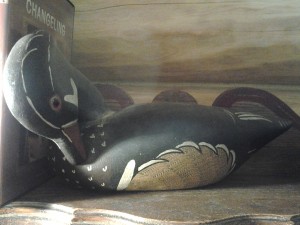 Rarely did we visit our storage to retrieve things. So if we’d followed the advice from all those organizing books, we would have given away our possessions and moved to our California cabin with only what we had in the RV.
Rarely did we visit our storage to retrieve things. So if we’d followed the advice from all those organizing books, we would have given away our possessions and moved to our California cabin with only what we had in the RV.
Here’s what I noticed in those three years that the three month trash bag test doesn’t address: Although I didn’t miss the objects in storage, I missed something very core for me that they collectively represent: Home. I missed my sense of place, of belonging to a place. I come from landed, rooted people and I’ve always framed my sense of safety and security around my sense of place.
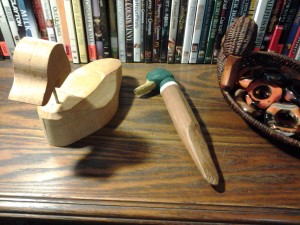 So there was no question that we would bring my decoys and my gemstones and my Blenko glass to California and position them lovingly on my sideboards and buffets. When C.T. and I wired in our stained glass lamp above the dining room table, a beacon shining all the way from our old cabin in the woods of Maryland to our new log home among the Ponderosa pines, some part of each of us exhaled. We are going to be okay.
So there was no question that we would bring my decoys and my gemstones and my Blenko glass to California and position them lovingly on my sideboards and buffets. When C.T. and I wired in our stained glass lamp above the dining room table, a beacon shining all the way from our old cabin in the woods of Maryland to our new log home among the Ponderosa pines, some part of each of us exhaled. We are going to be okay.
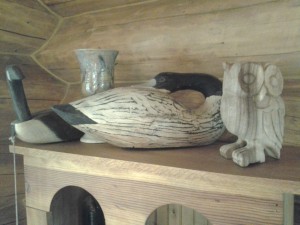 How did I start with decoy ducks? What is their meaning, past and present? I was a very young Sunday School teacher. My director, a mentor and second mother to me, called us together for a teacher training. We were to sample a curriculum that explored totem animals. Yes, it was a Unitarian-Universalist program, so totem animals. We were supposed to bring an item from home. Of course, ADHD me, I forgot mine. But what I had intended to bring was Fredrica, a mass-produced wooden decoy duck I’d picked up somewhere.
How did I start with decoy ducks? What is their meaning, past and present? I was a very young Sunday School teacher. My director, a mentor and second mother to me, called us together for a teacher training. We were to sample a curriculum that explored totem animals. Yes, it was a Unitarian-Universalist program, so totem animals. We were supposed to bring an item from home. Of course, ADHD me, I forgot mine. But what I had intended to bring was Fredrica, a mass-produced wooden decoy duck I’d picked up somewhere.
Why was I drawn to this object? At the time, I joked that I thought of myself as a “sitting duck” for conflict and controversy, like the working decoys that 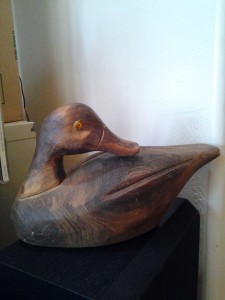 are used for hunting. I probably, even then, made some reference to the lines and curves, the rustic mood of the wood, the primitive style of the paint. Later, as I opened up to Paganism, I would appreciate that ducks are creatures equally comfortable in the air, water and on the ground. Leave the element of fire out of the equation; I’m vegetarian!
are used for hunting. I probably, even then, made some reference to the lines and curves, the rustic mood of the wood, the primitive style of the paint. Later, as I opened up to Paganism, I would appreciate that ducks are creatures equally comfortable in the air, water and on the ground. Leave the element of fire out of the equation; I’m vegetarian!
I started to collect little mass produced ducks and eventually started replacing those with serious signed art pieces by known carvers. Although my collection is humble by most collectors’ standards, I feel complete. For a while, friends and relatives would gift me ducks at every gift occasion. I had duck note paper and duck soap dishes. Most of those are long gone if favor of the art pieces I’ve managed to collect and I’ve trained folks out of giving me, well, anything.
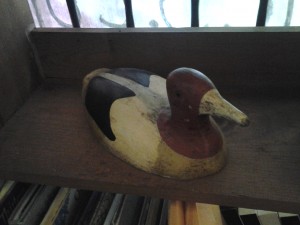 While people were gifting me ducks they started to threaten to buy me live ducks. Eventually one Easter I beat them to it by getting six Pekin ducklings at a feed store. I raised them in my classroom at the University of Louisville Child Care Center before moving them into my back yard. This began several years of living with live ducks. I came to favor black Indian runner ducks, with their wine bottle shaped bodies, scampering gait, and amazing iridescent peacock colored feathers.
While people were gifting me ducks they started to threaten to buy me live ducks. Eventually one Easter I beat them to it by getting six Pekin ducklings at a feed store. I raised them in my classroom at the University of Louisville Child Care Center before moving them into my back yard. This began several years of living with live ducks. I came to favor black Indian runner ducks, with their wine bottle shaped bodies, scampering gait, and amazing iridescent peacock colored feathers.
When I moved from my downtown Louisville home to Heathcote Community in the woods of Maryland, I moved my dog, ducks and goats to what I thought would be an idyllic life for all of us. But over a couple of years I lost my ducks to predation, mostly weasels. It was just too hard to give ducks freedom and safety in the woods.
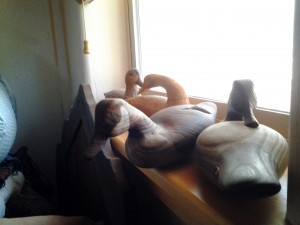 So now I live in the woods with dogs, goats and C.T., sitting in our log cabin among my folk art decoy ducks, creatures of the buffet, shelf, and the stereo speaker. They’re wood, lovingly carved into the round, comfortable shapes of creatures that make themselves at home even as they migrate, even as their place in the food chain makes home, family and life itself into gifts so easily taken away.
So now I live in the woods with dogs, goats and C.T., sitting in our log cabin among my folk art decoy ducks, creatures of the buffet, shelf, and the stereo speaker. They’re wood, lovingly carved into the round, comfortable shapes of creatures that make themselves at home even as they migrate, even as their place in the food chain makes home, family and life itself into gifts so easily taken away.
My decoys remind me that the security that defines sense of place is not absolute security, or even really true in the moment. It’s the familiarity of knowing one’s surroundings and letting the guard down. It’s building a nest even though it may be destroyed. It’s getting comfortable during the impermanence of life. Some would say it’s the point of life.
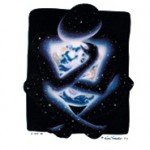
Leave a Reply
You must be logged in to post a comment.